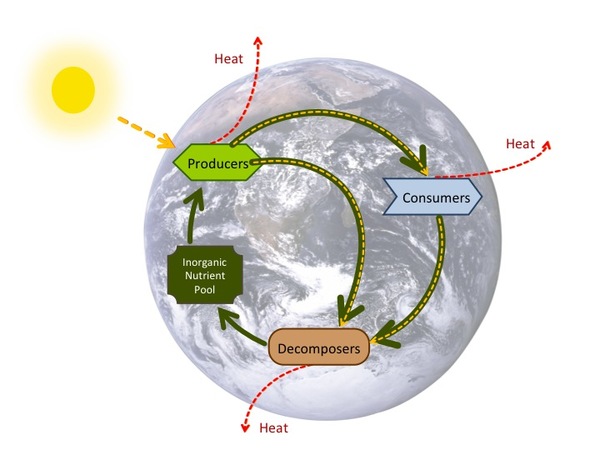| << Chapter < Page | Chapter >> Page > |
We are stardust, we are golden, we are billion year old carbon.- Joni Mitchell
Indeed, the elements that make up our bodies, and those of every other living thing, were born in dying stars, billions of years ago. And energy from our own star, the Sun, is an important player in making those elements available to living organisms on this planet. Energy flows directionally through ecosystems, entering as sunlight (or inorganic molecules for chemoautotrophs) and leaving as heat during the many transfers between trophic levels. However, the matter that makes up living organisms (
nutrients ) is conserved and recycled. The five most common elements associated with organic molecules—carbon, nitrogen, hydrogen, oxygen, and phosphorus—take a variety of chemical forms and may exist for long periods in the atmosphere, on land, in water, or beneath the Earth’s surface. Geologic processes, such as weathering, erosion, water drainage, and the subduction of the continental plates, all play a role in this recycling of materials. Because geology and chemistry have major roles in the study of this process, the recycling of inorganic matter between living organisms and their environment is called a
biogeochemical cycle . It is important to understand that energy, flowing through ecosystems, is also needed to drive biogeochemical cycles.

Water contains hydrogen and oxygen, which are essential to all living processes. The hydrosphere is the area of the Earth where water movement and storage occurs: as liquid water on the surface and beneath the surface, or frozen (rivers, lakes, oceans, groundwater, polar ice caps, and glaciers), and as water vapor in the atmosphere. Carbon is found in all organic macromolecules and is an important constituent of fossil fuels. Nitrogen is a major component of nucleic acids and proteins and is critical to human agriculture. Phosphorus, a major component of nucleic acids (along with nitrogen), is also one of the main ingredients in artificial fertilizers used in agriculture. Sulfur, an element that is involved in the 3–D folding of proteins (as in disulfide binding), is released into the atmosphere by the burning of fossil fuels, such as coal. Cycling and recycling of these chemicals from the environment to organisms and back again is critically important to all living things.
The cycling of these elements is interconnected. For example, the movement of water is critical for the leaching of nitrogen and phosphate into rivers, lakes, and oceans. Furthermore, the ocean itself is a major reservoir for carbon. Thus, mineral nutrients are cycled, either rapidly or slowly, through the entire biosphere, from one living organism to another, and between the biotic and abiotic world.

Notification Switch
Would you like to follow the 'Principles of biology' conversation and receive update notifications?